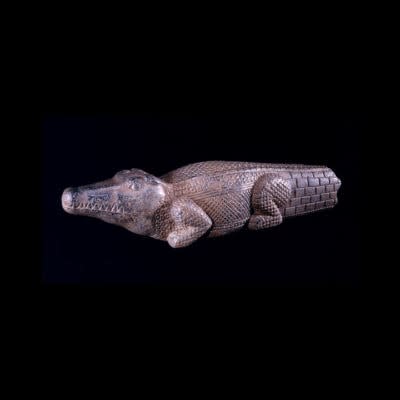Sculpture of Sobek in the Form of a Crocodile, 664 BCE - 525 BCE
Granite
7.6 x 7.3 x 32.1 cm
3 x 2 7/8 x 12 5/8 in
3 x 2 7/8 x 12 5/8 in
X.0189
Modern scholars believe that the worship of Sobek, the crocodile god, arose from a fear of these ferocious beasts. However, crocodiles were not universally feared in ancient Egypt. In certain...
Modern scholars believe that the worship of Sobek, the crocodile god, arose from a fear of these ferocious beasts. However, crocodiles were not universally feared in ancient Egypt. In certain regions, they were held sacred. Some were even tamed, kept in shallow pools and temples, embellished with jewelry and hand fed fresh meats, milk, and honey by reverent priests. While this may have been the case, it was certainly the exception; for throughout the greater part of the land, crocodiles remained a constant threat both to sailors cruising along the Nile as well as workers tilling the fertile banks of the mighty river. Sobek, the crocodile god, is either represented in the form of a crocodile, as he is here, or with the body of a human man with the head of the animal. A water deity, Sobek was the most popular deity in the oasis city of Arsinoe (renamed Crocodilopolis by the Greeks), one of the places where tamed crocodile were openly revered. Archaeologists have unearthed numerous examples of mummified crocodiles, and in some cases even their eggs, revealing the Ancient Egyptian’s honor for this powerful deity. The Nile was the life source of Ancient Egpyt, however, this waterway was filled with dangerous, unpredictable beasts. In order to mollify the danger of these wild animals, Sobek was honored with prayers, sacrifices, and libations, thereby ensuring a prosperous harvest and safe sailing.
This gray stone sculpture of Sobek in the form of a crocodile is a splendid example of the stylized naturalism that characterizes Egyptian art. While subject of the work is unmistakable and his head is rendered with a fair amount of realism, the texture of the body has been conveyed through a series of abstract patterns that appear more fanciful than imitative. However, while these patterns are clearly of the sculptor’s own creation, they do marvelously convey the thick, scaly hide of these beasts. The top of the crocodile’s back is filled with small donut-shaped markings that spill over onto hi neck. The sides of his body and his legs are marked by a diagonal grid pattern. Meanwhile, his fragmented tail is decorated with a larger brick pattern. These geometric patterns belie the naturalism of the face. His eyes and the skin around them have been carefully incised and his sharp fangs have been indicated by a series of triangles around his narrow mouth. A double-plumed headdress, perhaps made from a less durable material such as wood, may have originally been inserted into the hole in his head, thereby revealing his divine nature. Hundreds of years ago, when wild beasts still lurked alongside human civilization, this sculpture would have been worshipped in order to protect the people and ensure the prosperity of the Kingdom.
This gray stone sculpture of Sobek in the form of a crocodile is a splendid example of the stylized naturalism that characterizes Egyptian art. While subject of the work is unmistakable and his head is rendered with a fair amount of realism, the texture of the body has been conveyed through a series of abstract patterns that appear more fanciful than imitative. However, while these patterns are clearly of the sculptor’s own creation, they do marvelously convey the thick, scaly hide of these beasts. The top of the crocodile’s back is filled with small donut-shaped markings that spill over onto hi neck. The sides of his body and his legs are marked by a diagonal grid pattern. Meanwhile, his fragmented tail is decorated with a larger brick pattern. These geometric patterns belie the naturalism of the face. His eyes and the skin around them have been carefully incised and his sharp fangs have been indicated by a series of triangles around his narrow mouth. A double-plumed headdress, perhaps made from a less durable material such as wood, may have originally been inserted into the hole in his head, thereby revealing his divine nature. Hundreds of years ago, when wild beasts still lurked alongside human civilization, this sculpture would have been worshipped in order to protect the people and ensure the prosperity of the Kingdom.
